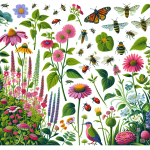This post may contain affiliate links. As an Amazon Associate, we may earn commissions from qualifying purchases.
Discovering the art of companion planting will not only enhance the beauty of your garden but also protect your cherished plants from troublesome pests without resorting to chemicals. By strategically placing certain plants together, you can create a harmonious environment that naturally deters insects and promotes healthy growth. Embrace these time-tested techniques to foster a thriving, eco-friendly garden. Have you ever wondered how to keep your garden free from pests without resorting to chemical pesticides? You’re in luck because companion planting offers a natural and eco-friendly solution to many pest problems. It’s a method that’s not just environmentally sound—it can also be incredibly effective when done right.

Understanding Companion Planting
Companion planting is an age-old agricultural technique where certain plant species are grown together to benefit each other. This practice harnesses the natural properties of plants to repel pests, attract beneficial insects, and enhance growth.
Why Companion Planting?
Companion planting has multiple benefits:
- Pest Control: Certain plants can deter pests through their scent or by attracting predators.
- Improved Growth: Some plants can provide essential nutrients or shade to neighboring plants.
- Biodiversity: Enhances the biodiversity in your garden, making it more resilient.
How Companion Planting Repels Pests
Plants interact with the environment in unique ways. Some release strong-smelling oils that pests find unappealing, while others attract beneficial insects that prey on pests. Understanding these interactions is key to effective companion planting.
Mechanisms of Pest Repellent
- Aromatic Compounds: Plants like mint or basil give off strong scents that deter pests.
- Trap Crops: Some plants attract pests away from your main crops.
- Predator Habitats: Flowers like marigolds can attract predatory insects, which prey on garden pests.
Examples of Pest-Repelling Plants
Here’s a quick look at some plants you can use in your garden:
| Plant | Pests Repelled |
|---|---|
| Marigold | Aphids, nematodes, whiteflies |
| Basil | Mosquitoes, flies, thrips |
| Garlic | Aphids, carrot rust flies |
| Mint | Ants, aphids, cabbage moths |
| Nasturtium | Aphids, whiteflies |
| Chives | Japanese beetles, aphids |
| Radishes | Cucumber beetles |
Best Practices for Companion Planting
Now that you have a foundational understanding, let’s delve into the best practices to make your companion planting as effective as possible.
Planning Your Garden Layout
Before you even start planting, plan your garden layout. Make note of the following factors:
- Sunlight: Different plants have different light requirements.
- Soil Requirements: Consider soil type and pH levels.
- Space: Ensure you provide adequate space for each plant’s growth.
Companion Planting Combinations
Some plants work exceptionally well together and can create a mini-ecosystem that repels pests. Here are some classic combinations:
Tomatoes and Basil
Basil not only makes tomatoes taste better but also repels mosquitoes and flies. Planting these two together can enhance the flavor of your tomatoes and keep pests at bay.
Carrots and Onions
Onions can help deter carrot flies, which are a common pest for carrots. In return, carrots can improve the soil structure for onions.
Cabbage and Dill
Dill attracts beneficial wasps that prey on cabbage worms and other harmful pests. Your cabbages will thank you for this companion.
| Combination | Benefits |
|---|---|
| Tomatoes & Basil | Repels mosquitoes and flies |
| Carrots & Onions | Onions deter carrot flies |
| Cabbage & Dill | Dill attracts wasps that eat pests |
Planting and Maintenance Tips
Even the best combinations will falter without proper planting and maintenance.
Rotate Your Crops
Crop rotation helps to break pest and disease cycles. Try to avoid planting the same crops or their relatives in the same spot each year.
Timing
Plant certain companions together that have similar growing seasons to maximize benefits.
Mulching
Mulching can help in pest control by creating a barrier between the plant and the soil, thereby preventing pests that reside in the soil from reaching the plants.
Common Mistakes to Avoid
Even seasoned gardeners make mistakes. Avoid these common pitfalls to ensure your companion planting is as effective as possible:
Overcrowding
It’s easy to get carried away, but too many plants competing for the same resources can be detrimental. Adequate spacing is crucial.
Ignoring Soil Health
Companion planting is not a magic bullet. Ensure your soil is healthy and well-fertilized for maximum benefits.
Wrong Combinations
Not all plants are good neighbors. For instance, avoid planting onions near beans or peas as they can inhibit each other’s growth.
| Mistake | Solution |
|---|---|
| Overcrowding | Maintain adequate spacing |
| Ignoring Soil Health | Regularly test and amend soil as needed |
| Wrong Plant Combinations | Research before planting |

Advanced Techniques
If you’re up for more complex strategies, there are several advanced techniques that can boost your companion planting efforts.
Trap Cropping
This involves planting a ‘sacrificial’ crop that attracts pests away from your main plants. Nasturtiums are excellent for drawing aphids away from other vegetables.
Push-Pull Strategy
This strategy initially developed for pest control in African maize fields, involves ‘pushing’ pests away from your crops and ‘pulling’ them towards trap plants. For instance, you could use dill to attract predatory insects that “push” pests away from your primary plants while using trap crops like nasturtiums to “pull” and trap pests.
Intercropping
Intercropping involves growing two or more crops in proximity. This can be especially effective for pest control. For instance, planting beans with corn can help deter corn earworms.
Companion Planting for Specific Pests
Let’s delve into some specifics. Below are some pest-specific strategies using companion planting:
Dealing with Aphids
Introduce:
- Marigolds: They repel aphids while attracting beneficial insects.
- Garlic: Planted near roses to deter aphids.
Handling Cabbage Worms
Introduce:
- Thyme: Effective at deterring cabbage worms.
- Dill and Fennel: Attract beneficial wasps that feast on cabbage worms.
Root Knot Nematodes
Introduce:
- Marigolds: Particularly effective against nematodes.
- French Marigold (Tagetes patula): Releases compounds that suppress nematodes.
Conclusion
Companion planting is an art and science that offers a natural solution to many pest problems in your garden. By understanding the symbiotic relationships between plants, you can create a thriving garden that’s naturally resilient to pests. With strategic planning, proper combinations, and timely care, you’ll reap the benefits of healthier plants and a more bountiful harvest. So go ahead and give companion planting a try—you and your garden might just become the best of friends.








